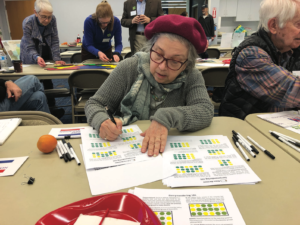 What It Does
What It Does
This organization models how technology and in-person engagement can be used to foster broad, deliberative participation. As the population of political districts has made opportunities to speak directly to our representatives more scarce, civic tech entrepreneurs have developed ways for citizens to communicate en masse. Online petitions and mass email campaigns are scalable, but one-dimensional means of conveying citizens’ views. In 2017 the Committee of Seventy, a Philadelphia-based good-government advocate, launched a statewide competition that invites Pennsylvanians to draw their own congressional map using an interactive online tool. Called Draw the Lines PA, this initiative helps citizens make informed and effective contributions to the debate on gerrymandering, fosters broad participation through in-person events, and facilitates face-to-face meetings between citizens and policymakers.
The project includes statewide contests, wherein citizen-drawn maps are evaluated on six criteria (compactness, population equivalence, etc.) and a personal statement demonstrating that the individual consulted with others about their map. High schools, colleges, and civic organizations throughout the state co-host events with Draw the Lines, including “mapathons” where people collaborate on maps. In addition to a cash prize, contest winners are invited to Harrisburg to present their map in the State Capitol.
How Effective It Is
Draw the Lines demonstrates citizens’ capacity to successfully engage on a complex subject. Since 2017, Draw the Lines has held two mapping contests that included over 150 in-person events, attracted more than 6,000 people, and resulted in 2,685 citizens creating maps on DistrictBuilder, the website hosting the redrawing tool.
Contest winners presented their maps in the State Capitol where representatives from 15 legislative offices were in attendance. Some 83% of participants reported that participation increased their knowledge of gerrymandering, while 60% said their involvement made them feel they could take action on the issue. This sense of efficacy stands in contrast to limited public input during Pennsylvania’s 2011 reapportionment process, when the Senate State Government Committee unveiled the map and voted to approve it on the same day without opportunity for public response.
The maps also provide policy makers with a more detailed account of citizen preferences than common alternatives like petitions, polls, or form letters sent by advocacy organizations. The more time-intensive and detailed a citizen’s communication is, the more seriously policymakers take it. Draw the Lines engages citizens with a complex policy issue and allows them to make a meaningful contribution to the debate on political representation.
How You Can Help
The cost of running a statewide contest, including $35,000 in total prize money, is about $320,000. Each contest’s events engage about 3,000 people, nearly half of whom register to use the online tool, translating to a cost of $357 per mapper.
Draw the Lines and parent Committee of Seventy rely exclusively on philanthropic support. Additional funding would enable it to reach more mappers and hold more “mapathons” at various high schools and colleges, which cost between $3,000 to $4,000. In its next round of contests, it hopes to grow the number of schools involved in the project from 50 to 90. Draw the Lines’ partners in schools and civil society have requested a mapping platform for redrawing state legislative districts. The mapping tool would cost between $30,000 to $40,000 up front and then an additional $2,500 per month to maintain online.
Funders interested in supporting similar efforts in other states can find citizen-led redistricting campaigns compiled by Common Cause.
